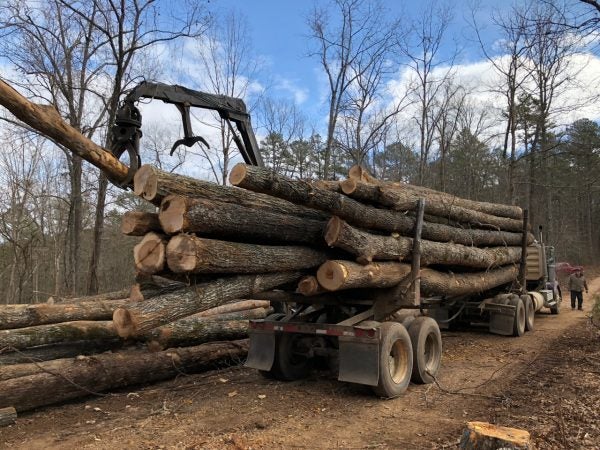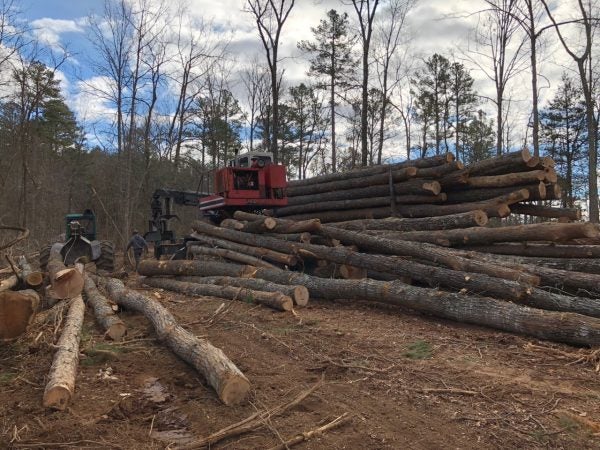Did logging help reclaim Missouri wilderness?
Since the 1950s, a timber company has used conservation-driven logging to balance productive use and wild forests.
Listen 6:21-

Tommy Fisk cuts down a black oak outside Eminence, Missouri on Dec. 14, 2017 (Zach Dyer)
-

Loggers load up timber cut on Pioneer Forest land outside Eminence, Missouri on Dec. 14, 2017 (Zach Dyer)
-

Gene Fisk, Sr. (left) and Jason Green look on as timber is stacked on to a truck in Pioneer Forest outside Eminence, Missouri on Dec. 14, 2017. (Zach Dyer)
-

Gene Fisk, Sr. looks on as timber is loaded on to a truck in Pioneer Forest outside Eminence, Missouri on Dec. 14, 2017. (Zach Dyer)
-

A skidder pulls logs from the forest before they’re loaded on to a truck. (Zach Dyer)
“I’m out planting a forest. Please leave your name and number, and I’ll try to get back to you before it matures. Thank you.”
For years, that’s what callers would hear when they dialed the office number of Leo Drey. Drey’s timber business, Pioneer Forest, owned more than 200 square miles of Missouri woods. But he was better known for conserving trees than cutting them down.
I visited some of the woods under Drey’s management on a cold December morning. The trees had long since dropped their leaves, leaving a crunchy brown carpet on the forest floor.
Before Drey died in 2015 at the age of 98, he transferred his forestland to the LAD Foundation, something he created so the forests would continue to be productive and wild. Some people might question whether those two concepts can live side by side, but — to my untrained eyes at least — it looks like Drey succeeded.
I meet a group of loggers who have been at work since sunup. One of the team is Pioneer’s chief forester, Brandon Kuhn.
“There’s equipment around and things like that so it maybe doesn’t feel as wild to us, but it certainly is,” Kuhn says. “I was marking timber on Monday this week, and I had an eight-point buck just walk right up to me.”
That buck would’ve been a rare sight by the time Drey started his timber business back in the early 1950s. The Ozarks were in rough shape then. In the late 1890s and into the 1920s, clear-cutting devastated much of southern Missouri’s virgin forests. Whole hillsides of shortleaf pine and oak were reduced to stumps.
Drey dreamed of regenerating this lost wilderness, and he came across a surprising way to do it: conservation-driven logging. Drey bought up overcut land for a bargain. By 1956, he was the largest private landowner in Missouri.
“The cutting of the trees I don’t think ever was something that Leo was very much interested in,” Kay Drey, Leo’s widow, says with a chuckle at her home in St. Louis.
“I think he got into this this whole field because he loved woods and the out of doors,” she says. “He realized that he could both preserve land and yet also have a have a way people could earn a living.”
Leo Drey decided if he wanted to protect his land in the long run, he had to put it to work — but only in a limited capacity. His approach focused on selecting individual trees for removal while preserving the rest of the woods. This kind of forestry is called uneven-aged management.
Drey’s dedication to uneven-aged management at Pioneer Forest had its share of skeptics over the years. The prevailing wisdom for decades was that clear-cutting was the best way to return these scraggly woods to their former glory. Others just thought he would never turn a profit and would have to sell the land.
But studies from the University of Missouri and other institutions have shown that Pioneer Forest land has recovered from the clear-cutting of the early 1900s. Today, the company sells more timber now than ever before.
Back in the woods of Pioneer Forest, chief forester Brandon Kuhn has been using a paint gun to mark trees ready for harvest. Company foresters walk through stands of trees once every 20 years or so to make these selections. The rest of the woods are left untouched.
“That’s just proof that you can generate income from your forest and actively manage it — and still increase volumes and have a healthier more vigorous forest than you did in the past,” Kuhn says.
Pioneer Forest isn’t wilderness if you’re thinking about a place untouched by people. That was something lost a long time ago here. But there is something wild about this place.
Leo Drey’s vision for this land helped turn hillsides full of stumps into a towering forest. The only cost is they have to cut down some trees to make it happen.
WHYY is your source for fact-based, in-depth journalism and information. As a nonprofit organization, we rely on financial support from readers like you. Please give today.






